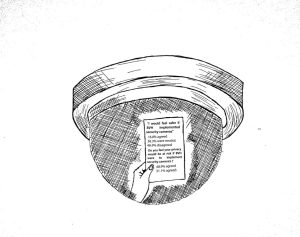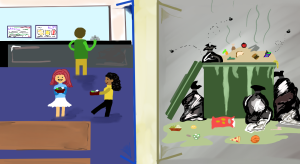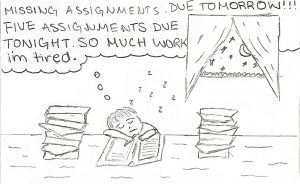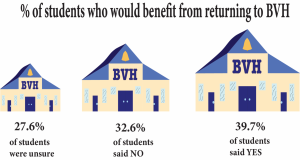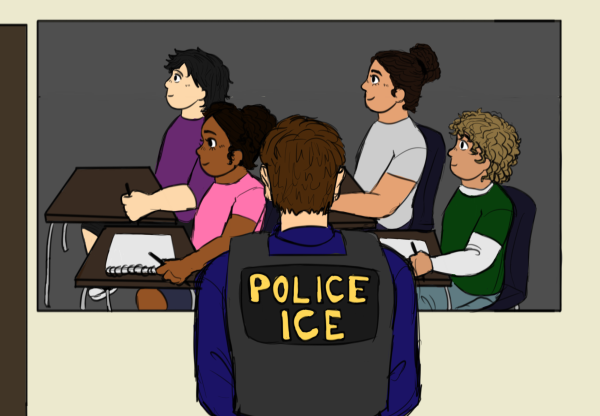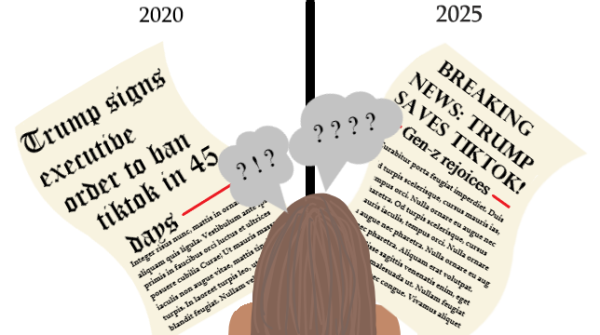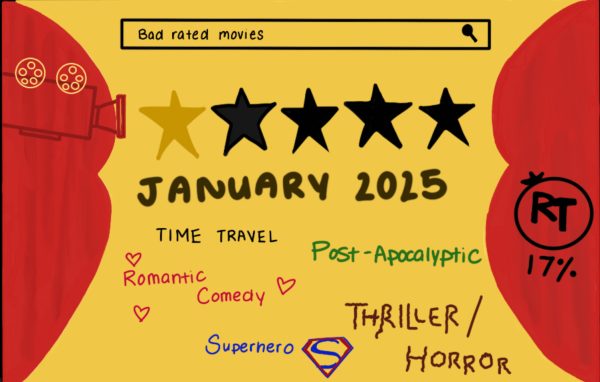Yes/No: Should BVH go back to distance learning amidst the rising COVID-19 cases?
Yes.
By: Nadia Martinez
Half-empty classrooms with barren seats that would have been filled by students, if not for the global pandemic, is what the current state of classrooms at Bonita Vista High (BVH) looks like. The chances of either getting exposed to COVID-19 or contracting the virus have increased exponentially due to the Omicron variant. The Centers for Disease Control and Prevention describes that the Omicron variant is more transmissible than the original COVID-19 virus.
Inevitably, students and staff alike have to quarantine for a minimum of 5 days as a result of either being exposed to COVID-19 or contracting the virus. With the second semester underway, the subject of whether BVH should return to distance learning is emerging. Firstly, too many students and staff are absent, secondly, we have already seen a shift towards distant learning, and lastly, despite BVH’s best efforts, too many people are becoming ill, therefore distance learning is the best alternative.
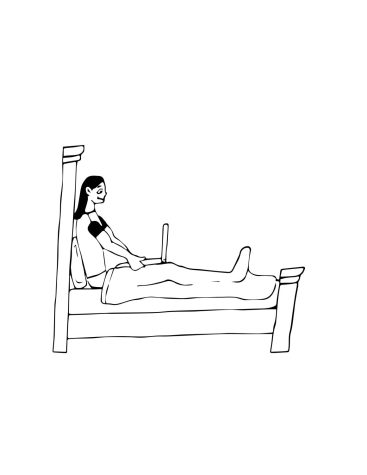
According to CNN, there are currently 749,553 COVID-19 positive cases in San Diego county alone. This number is only rising by the day. As a result of the increase in cases, more students and teachers have to leave school behind and work from home. Based on data compiled by the SUHSD, BVH has garnered a total of 20 COVID-19 cases in December of 2021 and went 95 total cases in January of 2022 among students and staff. With this, the more the community should transition back into distance learning.
The transition into distance learning at Bonita Vista High (BVH) has already begun. Hybrid learning marks the fork in the road for BVH to decide whether or not students and staff should move into distance learning. As American poet Robert Frost once said, the best road to take now is “the one less traveled by”. In this case, that road is distance learning, which is the safest option for both students and staff members, especially in a global pandemic.
BVH is already going through a crisis with the shortage of teachers and thus substitute teachers. This situation only exacerbates the issue of going to school in person during a pandemic. Although the Sweetwater Union High School District (SUHSD) is trying their best to minimize the spread of the virus by implementing the COVID-19 vaccination mandates. Unfortunately, this mandate is not enough because looking at the data provided by SUHSD, there was a 375 percent increase in COVID-19 cases from December of last year to January of this year in BVH alone.
Entire classrooms had to be shut down due to the number of positive COVID-19 students and staff. As part of the COVID-19 protocol, up to 10 healthcare providers and eight teachers were required to stay at home. BVH had to shut down two Moderate-Severe Special Education classes. This was done for the safety of both the staff and the students. Furthermore, the Special Education program’s specific curriculum makes it very hard for the class to transition to hybrid learning. Despite these efforts, entire classes are still afflicted.
Distance learning is our best option to keep our community safe and to further prevent the increase in COVID-19 cases. As we have already seen from the school year before, there are also some benefits to having distance learning. As the University of St. Augustine for Health Sciences explains an online learning environment can promote benefits such as being able to create a personalized own workspace, boost time management skills, develop self-motivation, self-discipline and much more.
SUHSD and BVH’s first priority should be the people they pledge to protect, which are the students and staff, but unfortunately, the school district and BVH are not living up to this promise. The COVID-19 virus and its variants are infecting too many people in such a short amount of time. This is why BVH staff and students should go back into distance learning for the health, safety and overall well-being of everyone. It may not be the easiest option but it is the safest and most favorable one.
No.
By: Jose Solis
When the COVID-19 pandemic first hit, schools across the United States (U.S.) had to continue school through remote learning in order to keep students, teachers and staff safe, where students studied and completed school work online at the comfort of their homes. However, distance learning came with a cost—students within Bonita Vista High (BVH) experience high levels of stress and emotions.
Recently, amidst in-person learning, students and teachers alike are faced with the dilemma of more absences and were confronted with the question of whether or not students should return back to distance learning. Although upholding safety precautions is important, distance learning could prove to raise worse problems than the issues regarding COVID-19 safety.
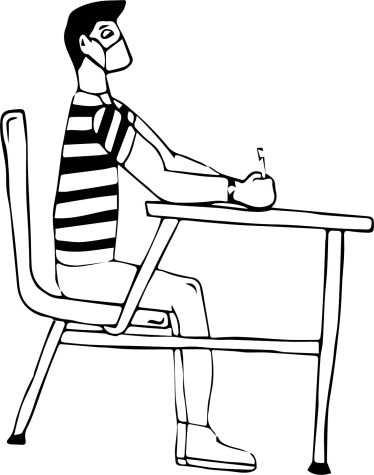
Feelings of anxiety were predominant in schools as 56 percent of students reported to be more stressed across the U.S. during distance learning, according to a study done by Challenge Success called ‘Kids Under Pressure’. In the same study, it was shown that students’ major stressors were cited to be “grades, tests and other assessments”, then “overall workload”, “lack of sleep” and “time management.”
During remote learning, BVH students had been finding it very challenging to stay self-disciplined by attending online classes and completing assignments, to the point where they fell behind in school as well as experienced poor time management and sleep deprivation. Paired with the workload, it was evident that the amount of stress resulted in a heavy mental toll on students, even those outside of BVH.
The Centers for Disease Control and Prevention explains that students’ mental states worsened to the point where mental health visits to Emergency Departments for adolescents, aged 12-17, increased 31 percent since 2019 during weeks 12-42 of the pandemic. This shows that through the pandemic, students and teens suffered worse mental states and mental health conditions.
Additionally, as students dealt with the stress from school, 43 percent of students said their sleep management got worse since the start of the pandemic, according to ‘Kids Under Pressure’. This led to the point where students dealt with more physical impairments, such as bodily pain, in conjunction with their mental states deteriorating.
Amidst the growing positive cases for COVID-19 and increased contact between people, students still want to feel safer because in-person learning makes them more susceptible to getting the virus. A poll of 896 students conducted by the Crusader the week of Jan. 31, revealed that approximately 40 percent of students would feel safer going back to distance learning. Those who wish to stay home and are able to quarantine would then have the ability to keep themselves safe from anybody who might have contracted the COVID-19 virus.
BVH implemented revised guidelines to ensure the safety of students, teachers and staff. The wearing of masks inside buildings are strongly enforced; most teachers also prohibit students from eating inside classrooms. With these safety precautions and weekly testing for COVID available every Monday, the BVH administration is doing their best to ensure student and staff safety, leading to students feeling safer in the present day. The same poll from the Crusader showed that 35 percent of students felt safe in school amidst the rising-19 COVID cases.
In response to the quarantine, BVH tried hybrid learning; where students can stay at home while other students can return to school. Hybrid learning can eventually lead to more engagement in class, safety and an overall better school experience during the harsh times that plague us.
With one group of students staying and the other going to school, there have already been benefits for people. According to the Center for Digital Education, “Since teachers will be working in class with only half of their students at a time, they can better focus on each student’s needs and learning goals.” In this way, students can learn and ask questions from both at home and on campus, and not only be safer if they want to be but not hinder the learning of those that want or need the campus to learn.
Ultimately, on-campus learning or hybrid learning provides a better experience for students because they are able to better focus on their academics without putting their mental and physical health at risk. Distance learning has led to the loss of sleep, missing assignments and students overexerting themselves to the point where they experience negative physical and mental impacts. For all that they went through before, students should not return to distance learning for the sake of upholding BVH students’ mental health.

I am a senior at Bonita Vista High and this is my second year on staff. I’ve always liked how unbiased and informative the crusader was and it was a...
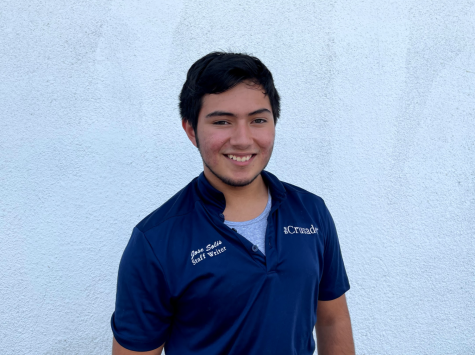
Hello readers, leaders, and Barons, not cheaters, I am a senior at Bonita Vista High and a second year staff member for the Crusader. I am one of the Podcast...
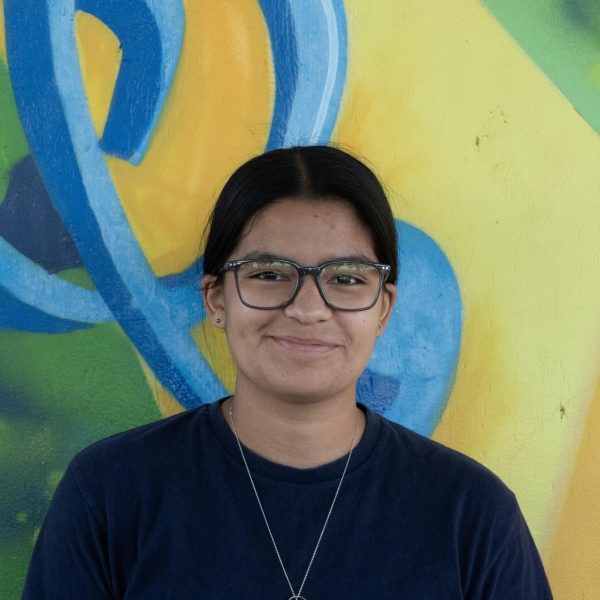
Hello! I am a senior at BVH, and I have been on the Crusader staff for all four years now. This year I am Co Editor-in-Chief and was previously the Editor-at-Large,...

